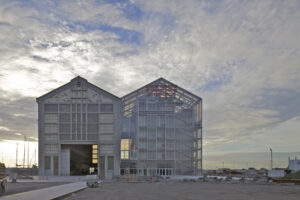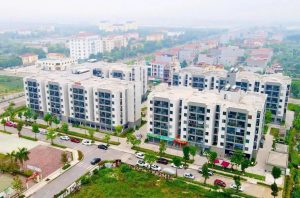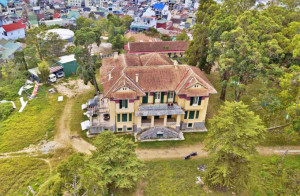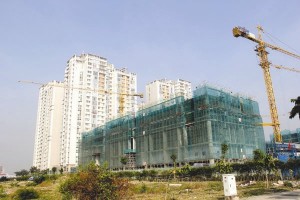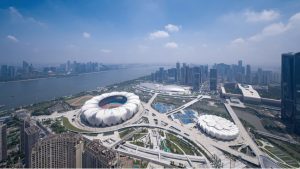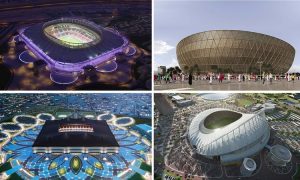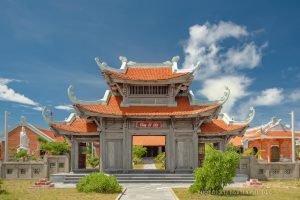Công bố quốc tế trong lĩnh vực kiến trúc, xây dựng (Tuần 2 tháng 10-2021)
Trong số này chúng tôi xin giới thiệu tới quý độc giả những nội dung chính của các công bố quốc tế đăng tải trên ScienceDirect và Springer Nature do Cục Thông tin khoa học và công nghệ quốc gia (NASATI) mua quyền truy cập như sau:
Quy hoạch đô thị:
– Khung hỗ trợ quyết định đa mục tiêu để ưu tiên các vị trí trồng cây trong đô thị
– Bản đồ độ phân giải cao của khu vực tầng đô thị của Trung Quốc đại lục
– Tương tác giữa đô thị hóa và môi trường sinh thái ở khu vực Pan-Third Pole
– Bổ sung ao nước trong cảnh quan đô thị bằng nguồn nước khai hoang: Sự thay đổi về mặt không gian của chất lượng nước và cơ chế ức chế tảo bằng bùn phèn
– Sự không đồng nhất trong đánh giá tiện nghi ngoài trời trong không gian công cộng đô thị
– Xác định các khu vực chính gây mất cân bằng cung và cầu của các dịch vụ hệ sinh thái ở quy mô tổng hợp đô thị: Một nghiên cứu điển hình về đồng bằng Phúc Kiến ở Trung Quốc
– Các yếu tố môi trường và kinh tế xã hội ảnh hưởng đến việc sử dụng không gian xanh đô thị ở Coimbra (Bồ Đào Nha)
– Tối ưu hóa đa mục tiêu của mạng lưới sưởi năng lượng mặt trời với hệ thống lưu trữ theo mùa cho các điều kiện ở các thành phố phía nam Chile
– Học số liệu sâu để truy xuất hình ảnh trong phát triển thành phố thông minh
Khoa học và công nghệ trong lĩnh vực kiến trúc, xây dựng:
– Tối ưu hóa vị trí camera dựa trên BIM để giám sát công trình trong nhà xem xét tiến độ thi công
– Giám sát và kiểm tra sức khỏe cấu trúc của đập dựa trên phép đo quang UAV với tái tạo hình ảnh 3D
– Bộ đôi kỹ thuật số và các ứng dụng trong lĩnh vực kỹ thuật dân dụng
– Tự động nhận dạng các phần tử của lớp lót đường hầm từ hình ảnh GPR bằng cách sử dụng mạng phức hợp sâu có tăng cường dữ liệu
– Thực tế ảo hỗ trợ lập kế hoạch bố trí cần trục tháp tương tác cho xây dựng tích hợp mô-đun cao tầng
– Tác động của hiệu suất vòng điều khiển đối với việc sử dụng năng lượng, chất lượng không khí và tiện nghi nhiệt trong các hệ thống tòa nhà với trình tự hoạt động tiên tiến
– Tối ưu hóa đa mục tiêu ra quyết định bảo trì và khôi phục mặt đường: Đánh giá quan trọng và định hướng trong tương lai
– Phát hiện các nguyên tắc thiết kế trực quan trong nghệ thuật và kiến trúc thông qua mạng nơ-ron phức hợp sâu
– Phương pháp tránh va chạm cho nhà tiền chế mô-đun robot
Vật liệu xây dựng:
– Tính chất và cơ chế chống cháy và ngăn khói trong chất kết dính nhựa đường có chứa montmorillonite hữu cơ
– Hoàn thiện đường cong ứng suất-biến dạng cho bê tông cốt sợi lá thông chịu nén
– Tính chất của bê tông cốt sợi bazan thân thiện với môi trường được thiết kế theo phương pháp Taguchi
– Nghiên cứu khả năng tạo đường của hỗn hợp dầu sinh học nhựa
– Mô phỏng ba chiều hỗn hợp bê tông nhựa kết hợp kích thước cốt liệu và sự phân bố hình thái dựa trên phương pháp động lực học tiếp xúc
– Đánh giá hiệu suất của tổ hợp đất sét nung đá vôi (LC2) như một chất thay thế xi măng trong các hệ thống bê tông chịu đóng rắn bằng nhiệt trong thời gian ngắn
– Quá trình nứt vỡ và tiêu hao năng lượng của cát kết khi chịu tải tác động lặp đi lặp lại với các tốc độ gia tải khác nhau: Từ quy mô vi mô đến vĩ mô
– Phương pháp mới kiểm soát nhiệt độ bê tông khối lớn bằng thủy lực: Thiết kế và thử nghiệm
– Ảnh hưởng của sợi bazan có hàm lượng canxi cao đến khả năng gia công, tính chất cơ học và cấu trúc vi mô của vật liệu vữa geopolymer tro xỉ
– Nghiên cứu phát triển bền vững vữa xi măng vật liệu hạt mịn
Xin trân trọng giới thiệu!
QUY HOẠCH ĐÔ THỊ
- Revitalizing historic districts: Identifying built environment predictors for street vibrancy based on urban sensor data
Cities, Volume 117, October 2021, 103305
Abstract
Vibrancy is indispensable and beneficial for revitalization of historic districts. Hence, identifying built environment predictors for vibrancy is of great interest to urban practitioners and policy makers. However, it is challenging. On the one hand, there is no consensus in selection of appropriate proxy for vibrancy. On the other hand, the built environment is multidimensional, but limited studies examined its impacts on vibrancy from different dimensions simultaneously. The Baitasi Area is a typical historic district in Beijing, China. In this study, on the basis of a long-term repeatedly measured dataset generated from the Citygrid sensors, we investigated the spatiotemporal distribution of street vibrancy in Baitasi Area and examined its built environment predictors in two seasons (i.e., summer/autumn and winter), with pedestrian volume as the proxy for vibrancy and built environment portrayed from four different dimensions (i.e., morphology, configuration, function, and landscape). We found that (1) the street vibrancy in Baitasi Area is temporally relatively evenly distributed, but with higher spatial concentration; (2) microclimate and built environment are more significant in winter than in summer/autumn; (3) street morphology and configuration features are more significant predictors than street function and landscape features; (4) generally, streets with higher point of interest (POI) diversity, higher buildings, and stronger network connection tend to have higher vibrancy. This study provides decision makers with insights in revitalizing historic districts.
- A multi-objective decision support framework to prioritize tree planting locations in urban areas
Landscape and Urban Planning, Volume 214, October 2021, 104172
Abstract
With tree planting initiatives being undertaken in different cities, careful thought needs to be put into the placement of trees, the beneficiaries of ecosystem services from these trees, and the potential impacts of alternative tree planting schemes. Using a spatially explicit methodology within biophysical ecosystem service models, this research develops a multi-objective decision support framework to guide future greening initiatives towards prioritizing planting locations that maximize multiple objectives. In a case study application of the framework in the Bronx, NY, the analysis utilizes spatially distributed census block group data and linear programming, a mathematical optimization technique, to identify optimal and equitable planting locations considering increases in tree cover, monetary benefits from avoided runoff, PM2.5 air pollutant removal and heat index reduction as well as tree planting costs and the equality and equity of urban tree ecosystem services. Using different optimization scenarios, the framework identifies optimal planting schemes by minimizing planting costs, maximizing increases in tree cover and ecosystem service benefits, and the equity of canopy cover and ecosystem services, arriving at a wide range of different planting recommendations. We conclude that multi-objective prioritization frameworks can identify optimal locations for greater total benefits from urban greening and that the proposed framework has the potential to inform decision making in different cities.
- Building safer public spaces: Exploring gender difference in the perception of safety in public space through urban design interventions
Landscape and Urban Planning, Volume 214, October 2021, 104180
Abstract
Concern around personal safety is a significant factor in constraining women’s access to and use of public space. One strategy presented to address this involves altering the design of built environments. However, tension and controversy surround these arguments in the literature on safety perception in public space. This study seeks to explore whether the presence of three design interventions commonly cited in the literature act to enhance or reduce perceptions of safety in public space, focusing on women’s experiences in particular. Three design interventions are examined: public toilets, solid walls, and graffiti removal. To test these interventions, an image-based randomised control trial with 104 participants was conducted in 2018 in London (UK). A series of control and treatment images simulating each design intervention was viewed and ranked by participants according to perceived safety. The findings of this study suggest that: the presence of public toilets does not affect perceived safety; eliminating graffiti has a weak significant impact on perceived safety; and removing solid walls leads to significant improvements of perceptions of safety, with the effect being stronger for women. These results suggest that to maximise investment effectiveness, urban design and planning policies that aim to increase perceptions of safety should be evidence-based, and need to integrate a gendered perspective. The presented technique could support urban design processes by examining the safety-enhancement impact of proposed public space interventions prior to their being rolled out.
- High-resolution mapping of mainland China’s urban floor area
Landscape and Urban Planning, Volume 214, October 2021, 104187
Abstract
Urbanization studies are of global interest and mainly focus on mapping urban areas and areas of expansion using remote sensing data. However, information about the 3-dimensional characteristics or expansion of urban buildings is absent due to difficulties in data acquisition. Quantifying the urban floor area is crucial for assessing urban 3-D morphology. We used a random forest regression model to predict the first urban floor area of mainland China at a 130-m spatial resolution based on high spatial resolution nighttime light LUOJIA 1-01 images (130-m), a population map (100-m), and a single building dataset encompassing 71 cities. The predicted floor area (PFA) map for mainland China was estimated from the single building dataset of 50 cities, and data from the other 21 cities were used to estimate the accuracy. The results showed that the total accuracy of the PFA map is strong (R2 = 0.68, RMSE = 7277.46 m2/ha). The PFA map overestimated the values in low value areas and underestimated the values in high value areas. The accuracy was also acceptable at the single city scale based on the results from six cities (R2 > 0.6). The calculated floor area map for 71 cities was merged with the PFA map by replacing the values in the corresponding locations to generate the final predicted floor area (FPFA) map, which enabled higher accuracy. The total floor area is 76038.39 km2, which is 0.79% of the total area of China. The general distribution of the floor area amount and intensity showed that the coastline had a higher intensity than the inner region of the country and the southern region had a higher intensity than the northern urban area along the coastline. The floor area distribution was extremely uneven among the provinces. The top six provinces represent 50.01% of the total floor area; however, the last six provinces represent only 3.31%. The high spatial resolution FPFA map of mainland China calculated by us has great potential application in urban ecology research, such as the impact of FPFA on heat island and haze.
- Potential restorative effects of urban soundscapes: Personality traits, temperament, and perceptions of VR urban environments
Landscape and Urban Planning, Volume 214, October 2021, 104188
Abstract
This study investigated the potential restorative (PR) effects of urban soundscapes. To establish a new set of PR criteria for urban environments, this study recreated 10 urban sites in virtual reality, instead of using the typical method of questionnaires. A list of restoration-related semantic terms was derived from narrative interviews of 50 subjects who freely expressed their perceptions of the space. PR criteria were determined based on the derived list and two groups were found: the PR group and potential non-restorative group. The objective characteristics of urban soundscapes—acoustic and visual characteristics and characteristics of moving objects—were analyzed. Participants provided their subjective responses regarding sound source identification, perceived affective quality, and overall quality. The Temperament and Character Inventory-Revised-Short Version and Satisfaction with Life Scale were utilized to analyze participants’ individual characteristics. Based on it, a model was developed to predict whether PR criteria could be satisfied, which was 82.6% accurate (85.9% specificity, 71.8% sensitivity). It was determined that the overall level of preference regarding an urban soundscape is a significant factor in satisfying PR criteria. In particular, the design and planning of urban spaces should aim to reduce a space’s loudness and increase the revisitation rate to promote the restoration of the urban residents’ mental health. Furthermore, for individuals, a trait based on acquired experience has a greater impact on the PR effects of urban soundscapes than innate temperament. This study’s findings can serve as supporting data to design sustainable and health-promoting urban soundscapes.
- Interaction between urbanization and the eco-environment in the Pan-Third Pole region
Science of The Total Environment, Volume 789, 1 October 2021, 148011
Abstract
Due to the high ecological vulnerability of the Pan-Third Pole region and the complexity of its ecological process, the impact of urbanization on the ecological environment (eco-environment) in this specific region attracts global attention. Here, we established an effective framework to evaluate the coupling coordination process of urbanization and eco-environment, and investigated the spatial distribution and dynamic evolution of this coupling coordination. Results showed that the Pan-Third Pole is undergoing an accelerated process of urbanization. Meanwhile, the overall eco-environment has profoundly changed from an ecological reserve to an ecological deficit. The coupling degree between urbanization and eco-environment shows an upward trend, and the decoupling process dynamically changes between various types. Regional convergence is remarkably embodied in the coupling and decoupling types. We found four coupling categories and three decoupling categories for the interaction between urbanization and eco-environment. Among them, the first coupling category contains 35 countries, which maintained a basically coordinated pattern with eco-environment lag. The initial urbanization level of the first category was higher than 35%, indicating that countries with higher urbanization levels were more likely to achieve coordinated development between urbanization and eco-environment. There was a noteworthy “path-dependence” in the evolution of the coordinated relationship between urbanization and eco-environment in the Pan-Third Pole. These findings will have important policy implications for decision-makers to explore coordination and sustainable development path for urbanization and eco-environment conservation.
- Replenishment of urban landscape ponds with reclaimed water: Spatiotemporal variations of water quality and mechanism of algal inhibition with alum sludge
Science of The Total Environment, Volume 790, 10 October 2021, 148052
Abstract
Algal blooms caused by high concentrations of nutrients (especially phosphorus) limit the use of recycled water (RW) for replenishing landscape ponds in the context of global water scarcity. Previous studies have demonstrated that alum sludge is a low cost phosphorus sorption medium, which could potentially be applied in constructed wetlands and sewage treatment plants. However, whether alum sludge can be used for algae inhibition in reclaimed water urban landscape ponds (RWULPs) should be explored. In this study, phosphorus removal and algae inhibition by alum sludge were investigated in a RWULP in China. The results highlight that there is a serious risk of algal blooms in RWULPs. The algal density was found to be 1.58 × 105 cell·mL−1, which is 6.84 times higher than that of the surface water ponds. The algal blooms presented a Cyanophyta–Chlorophyta–Bacillariophyta-type, and the dominant algae species were Microcystis flos-aquae (Wittr.) Kirchner, Chlorella vulgaris, and Scenedesmus quadricauda. Moreover, the removal rate of phosphorus by alum sludge was as high as 98% and eventually leads to phosphorus stress, which has an important effect on algae growth and algae inhibition rate of 80%. In addition, the proportion of phosphorus and nitrogen in the adsorbed alum sludge increased by 3.12% and 0.32%, respectively, and Al3+ was reduced by only 2.18%. Alum sludge is a potential inhibitor of algae in RWULPs that does not negatively impact the environment. These results are of great importance in algal bloom control of RWULPs and may help alleviate the problem of urban water resource scarcity.
- Heterogeneity in outdoor comfort assessment in urban public spaces
Science of The Total Environment, Volume 790, 10 October 2021, 147941
Abstract
The assessment of outdoor comfort can provide valuable insights into the quality of urban public spaces. Rational indices based on the heat-balance model have been extensively used for assessing thermal comfort in various outdoor environments for a long time. However, a growing body of literature is arguing the theoretical limitations of rational indices, including the lack of contextual considerations and the non-consideration of the active role of human being. Furthermore, the well-documented inconsistency in previous investigations suggests individuals’ heterogeneous thermal expectations, preferences and adaptations typically depend on person-related and place-related contexts. Nevertheless, the study of heterogeneity in comfort assessment remains fragmentary. In an attempt to incorporate heterogeneity into a comprehensive conceptual framework of outdoor comfort, this study develops a latent class path model based on empirical data of 701 respondents from Eindhoven, the Netherlands. We identified two latent classes associated with different causal structures underlying the assessment of outdoor comfort. Meanwhile, the membership of latent classes is identified based on respondents’ socio-demographic and behavioral covariates. The results show that, with respect to the influence on comfort assessment, the exogenous and endogenous variables are varying in effectiveness and strength between the two latent classes. Latent class 1 assesses the outdoor comfort mainly based on thermal sensation and expectations of thermal and wind conditions, whereas latent class 2 comprehensively considered both thermal and non-thermal influences, especially, the psychological acceptability and need satisfaction of outdoor activity. Our findings suggest that, in addition to the expanded framework of outdoor comfort study, understanding the heterogeneity in respondents’ comfort perception is needed to comprehensively address the approaches to archive the comfortable urban public spaces in design, planning and management practices.
- Identifying key areas of imbalanced supply and demand of ecosystem services at the urban agglomeration scale: A case study of the Fujian Delta in China
Science of The Total Environment, Volume 791, 15 October 2021, 148173
Abstract
The coordinated supply and demand of ecosystem services (ESs) is important for ensuring regional sustainable development. However, research identifying key areas of imbalanced supply and demand of ESs at the urban agglomeration scale is limited. Therefore, in this study, using the Fujian Delta urban agglomeration of China as the research area, based on multi-source data, and analysis tools, such as ArcGIS, ENVI, and GeoDa, we constructed a research framework and indicator system for ESs supply and demand to determine the spatial change law, matching degree, and coupling coordination degree (CCD) of the ESs. On this basis, the key areas of imbalanced supply and demand of ESs were identified, and optimization strategies were proposed. The results showed that (1) there is obvious spatial heterogeneity between ESs supply and demand in the study area, and different degrees of spatial changes occurred with urbanization. Specifically, areas with large changes were concentrated in urban core areas and economic development zones. (2) The matching degree between ESs supply and demand is quite diverse and shows a trend of polarization. Under the influence of urbanization, some cities began facing ESs supply shortages. (3) Overall, the CCD between ESs supply and demand in the study area is in a state of mild incoordination, but with increasing urbanization, some cities have turned into a state of extreme incoordination. Our results indicate that the ESs supply and demand status in some cities at the urban agglomeration scale has become increasingly severe. Therefore, it is necessary to focus on certain “key areas” to formulate optimization strategies. For key areas with “low supply-high demand” and extreme incoordination, the population and land use intensity should be controlled to reduce the ESs demand level. Meanwhile, for key areas with “high supply-low demand” and extreme incoordination, the utilization efficiency of ecological resources should be improved to enhance the ESs supply capacity. The results of this study will help decision-makers optimize the relationship between ESs supply and demand in order to achieve the sustainable development of urban agglomeration.
- Environmental and socioeconomic factors influencing the use of urban green spaces in Coimbra (Portugal)
Science of The Total Environment, Volume 792, 20 October 2021, 148293
Abstract
Urban green spaces (UGS) deliver a wide range of regulating, provisioning and cultural ecosystem services (CES), relevant to support the achievement of some United Nations Sustainable Development Goals (e.g., Goal 11: sustainable cities and communities, and Goal 3: good health and well-being). However, knowledge of preferences and uses of UGS by urban dwellers is still lacking. This study assesses the CES perceived by different users in five distinct urban parks located in Coimbra, Portugal: Manuel Braga (secular park), Botanical garden, Choupal national forest, Mondego green park (large area placed next to the river), and Vale das Flores (linear park located in a residential area). A questionnaire survey was performed in each park to investigate the activities performed and their relevance for the users, users’ motivations to develop the activities on that specific UGS, the perceived benefits regarding physical and emotional well-being and social interactions, and users’ perception about disservices. The results showed that walking, meeting people, practicing and doing activities with children are the activities performed by most users and are perceived as beneficial for physical and emotional well-being. Multifunctionality is a characteristic of all parks and highly appreciated by the users. Significant differences in socio-demographic characteristics of the users and motivations are recorded between parks. The tranquillity of space and landscape beauty are the main motivations to use Manuel Braga Park and the Botanical garden. Distance to the park and transportation means are particularly important for Botanical garden and Vale das Flores park users. Age group and average monthly income were associated in both Choupal national forest, Mondego green park and Vale das Flores park, denoting that older and wealthier users are more able to enjoy these parks. Users’ problems or ecosystem disservices were not identified, although plagues (e.g., mosquitoes) and dangerous animals recorded average concerns in the Choupal national forest and in the Vale das Flores and Mondego green parks. This work’s findings can help decision-makers better understand users’ needs and expectations, thus improving UGS design and management to attract more citizens.
- Hybrid framework for rapid evaluation of wind environment around buildings through parametric design, CFD simulation, image processing and machine learning
Sustainable Cities and Society, Volume 73, October 2021, 103092
Abstract
High-efficient evaluations of building performance are often required for comparisons of different design alternatives in architectural sustainable design processes. General Computational Fluid Dynamics (CFD) simulations are usually complicated and time-consuming for wind environment investigation and evaluation. A hybrid framework for rapid evaluation of pedestrian-level wind environment will be proposed in the present work. This framework will then be formulated by integrating parametric design, CFD simulation, image processing, and machine learning, and it could immediately predict the Low-Velocity Areas (LVAs) around rectangular-form buildings. A large amount of data of 300 building cases generated by parametric design, CFD simulation, and image processing to train a Machine Learning Model (MLM) could be applied for the prediction of LVAs. In the case investigations, MLM was tested in the prediction of the other new 24 building cases with random geometric parameters. The comparison of MLM and CFD results showed that their solutions were close to each other. Efficiency and accuracy of the hybrid framework were further demonstrated through quantitative analysis of statistical discrepancies of MLM and CFD results. Hybrid framework was an original attempt to integrate multiple emerging computational tools, and it could provide high-efficient quantitative analysis of wind environment and give practical design optimization information in the early stage.
- Urban and social vulnerability assessment in the built environment: An interdisciplinary index-methodology towards feasible planning and policy-making under a crisis context
Sustainable Cities and Society, Volume 73, October 2021, 103082
Abstract
The current global crisis on Covid-19 has an adverse impact on urban regeneration of the built environment in emerging countries, with a recent world GDP drop of around 4.9 % and around 20–30 % decrease in economic funds intended for renovation policies, being required new decision support mechanisms to diagnose and quantify the vulnerability of existing neighbourhoods, aiming to conduct feasible and adjusted regeneration strategies. This research contributes with a novel interdisciplinary index-methodology for assessing the adequacy of housing environments with social backwardness, based on a dual weighting procedure of four main dimensions: Building, Urban, Environmental and Social (BUES), calculated through technical inspections, from technicians, together with social questionnaires, from users, with respect to 32 variables related to housing environments, urban services, and environmental issues. The operation and replicability of the system are tested in two representative neighbourhoods from Mexico and Spain, identifying most important weaknesses and needs according to each variable and displayed results, discussing a 0.7 points of deviation average from technicians and users in a 1–5 Likert scale. Conclusions incorporate important outcomes for urban policy-makers and technicians, providing methodological implications for adjusting public aids to promote effective regeneration guidelines based on a proper decision-making under an austere economic context.
- Multi-objective optimisation of a solar district heating network with seasonal storage for conditions in cities of southern Chile
Sustainable Cities and Society, Volume 73, October 2021, 103087
Abstract
Rapid urban growth and enhanced quality of life have significantly increased the demands for indoor heating, especially in the developing world. In Chile, this demand is provided largely through low quality biomass which creates pollution problems. Due to the medium to high solar resource in most of Chile, solar thermal networks with seasonal thermal storage should be considered. In this paper, we assessed the use of solar energy with seasonal thermal energy storage to provide domestic heating through a heat network. For this, we performed a simulation-based multi-objective optimisation of the system’s design with cost and greenhouse gas emissions as objectives for two locations in Chile. Our results show that solar thermal networks are cost-competitive with conventional alternatives. Furthermore, the inclusion of seasonal thermal storage could improve the system performance decreasing the emissions by around 90% while increasing the by less than 20% compared with a conventional gas-heated network or resistive electric heating. We found that for specific system configurations and locations solar district heating with long term storage could be cost-competitive with burning firewood if externalities such as the social costs of local pollution were considered in the economic analysis.
- Effects of landscape patterns on the summer microclimate and human comfort in urban squares in China
Sustainable Cities and Society, Volume 73, October 2021, 103099
Abstract
This research uses empirical data and supplementary computer simulation result to study the summertime cooling effect of different landscape patterns in urban areas in China. It employs field monitoring to collect hourly air temperatures and relative humidity at pedestrian level over five consecutive days in July 2016, and calculates the discomfort index for each scenario in studied urban squares. It also builds simulation models using Citysim and Meteonorm software to further explore the cooling effects of different landscape patterns within the same square. The results from field research show that the difference in cooling and humidification amongst the four landscape patterns is significant, as is the thermal comfort or discomfort caused by such effect. The research finds that the urban square equipped with only hard paving and no canopy coverage could cause extreme discomfort and heatstroke during summertime in the studied climate, whereas the urban square with lawn grass, high canopy closure and thick canopy can reduce discomfort. The simulation analysis further confirm that lawn grass can noticeably reduce the ground surface temperature and the surface temperature of the surrounding buildings than if using asphalt as the ground cover. The findings from this research provide design guidance for the landscape configuration of urban squares in similar climates.
- Deep metric learning for image retrieval in smart city development
Sustainable Cities and Society, Volume 73, October 2021, 103067
Abstract
Deep metric learning (DML) aims to learn a consistent distance embedding where an anchor is closer within the same category than others. It underpins a variety of essential and significant tasks in the development of smart city including face recognition, landmark retrieval, pedestrian detection, person/vehicle re-identification, and so on. Traditional pair-based DML methods try to make full use of the data-to-data relations within a (mini-)batch, but they cannot grasp the data distribution information due to the batch size limitation. On the other hand, proxy-based DML schemes use different proxies to approximate the data distribution. However, the proxies are too sample to represent the intra-category variance. In this paper, we propose a simple but effective method, named soft-instance-label proxy, for embedding learning. It can capture the globe data distribution information while depicting the detailed intra-class data structure. The state-of-the-art empirical results on three public image retrieval benchmarks and two backbone networks demonstrate the superiority of our proposed method. Our Soft-instance-label proxy method can have a Recall improvement of 2.4% with Googlenet, largely surpassing the current state-of-art-methods while demonstrating great potential in the development of smart city.
KHOA HỌC VÀ CÔNG NGHỆ TRONG LĨNH VỰC KIẾN TRÚC, XÂY DỰNG
- Impact of Urban Water Networks on Microclimate and PM2.5 Distribution in Downtown Areas: A Case Study of Wuhan
Building and Environment, Volume 203, October 2021, 108073
Abstract
Rapid urbanization in China has resulted in highly dense urban forms and marked reductions in ecological resources, which in turn have caused severe urban heat islands and PM2.5 pollution. In typical cities with a water network, such as Wuhan, the use of water resources to improve the urban climate environment has become an urgent issue. In this study, we explored the impact of water networks on the microclimate and PM2.5 distribution in Wuhan by using multi-source remote sensing data and the weather research and forecasting model. Our results indicated that the water network has a blocking effect on PM2.5. Taking pollutant sources into consideration, the coverage of the water surface is positively correlated with a PM2.5 concentration of 0.606–0.703; the concentration of PM2.5 over suburban lakes with an area larger than 60 km2 is approximately 6%–13% higher than that of the surrounding land surface. We also found that the water network reduced the average temperature of the downtown and the urban hinterland at noon by 1 K and 0.5 K, respectively, and increased the height of boundary layer at night by more than 60 m—an approximately one-third increase—which helped decrease the level of PM2.5. In addition, the impact of water bodies located in different “ring loops” on the downtown microclimate varied significantly. Water bodies located downtown significantly increased the night wind speed in downtown areas to as much as 2 m/s, while those in nearby and outer suburbs increased the wind speed downtown by more than 1 m/s at noon.
- Effect of greening on pollutant dispersion and ventilation at urban street intersections
Building and Environment, Volume 203, October 2021, 108075
Abstract
To improve ventilation efficiency and reduce pollution concentration in urban spaces, eco-strategies, including greening, have been suggested. However, there is still very little evidence to assert the benefits of such greening options, particularly at urban street intersections. Therefore, in this work, air flow and pollutant dispersion within urban-like three-way, four-way, and roundabouts intersections are investigated with three simple and five combined greening layouts. Three-dimensional computational fluid dynamics (CFD) analysis using the Reynolds-averaged Navier–Stokes model was conducted considering multiple wind directions. The ventilation efficiency was evaluated using the ventilation indices purging flow rate (PFR) and net escape velocity (NEV). The investigation of simple greening layouts shows that shrubs alone may enhance increase ventilation (i.e., increase PFR and NEV), and trees could increase the pollutant concentration at the pedestrian level. A comparison of greening layouts combining trees and shrubs shows that the presence of greening reduces ventilation and worsens the pollution condition at street intersections, except for shrubs located in the central zone within roundabouts. Specifically, NEV decreases by 16%–43% at four-way and three-way intersections owing to the presence of greening. Greening layouts with two rows of trees located 2.2 m away from buildings show overall significant negative effects on ventilation, particularly for wind directions ϕ = 0°, 45°, and 90°. The impact of shrubs and trees on ventilation at the roundabout is less significant, with NEV varying by 4%–11%.
- BIM-based optimization of camera placement for indoor construction monitoring considering the construction schedule
Automation in Construction, Volume 130, October 2021, 103825
Abstract
Construction cameras have been used to support autonomous job site monitoring in recent years. However, it remains challenging to find the optimal camera placement configuration in a dynamic job site environment. To address this problem, this paper proposes a camera placement optimization framework using building information modeling (BIM). The framework considers changes in dynamic obstacles and working areas in different construction stages. Data image is used as the data mediator to connect the three modules (BIM module, mathematical module, and optimization module), visualizing the site discrete and optimized result. The efficiency of the framework is validated through the test of an indoor construction project with a size of 2000 square meters. Compared to the experience-based camera placement configuration, the optimal camera placement calculated by the proposed framework achieves 12% improvement in total coverage.
- Real-time multiple damage mapping using autonomous UAV and deep faster region-based neural networks for GPS-denied structures
Automation in Construction, Volume 130, October 2021, 103831
Abstract
An autonomous unmanned aerial vehicle (UAV) system integrated with a modified faster region-based convolutional neural network (Faster R-CNN) is proposed to identify various types of structural damage and to map the detected damage a GPS-denied environment. The proposed method reduces the number of false positives significantly using a real-time streaming protocol and multi-processing, particularly in the case of very small cracks in blurry videos due to the UAV vibrations. In comparative studies, the modified Faster R-CNN using ResNet-101 as the base network showed superior performance in detecting small and blurry defects with a mean average precision of 93.31% and mean intersection-over-union of 92.16% in video frames captured by the low-cost autonomous UAV. The autonomous flights of the UAV were tested in a real large-scale parking structure to account for the high wind effects during flight. The UAV successfully followed the desired trajectories, and the Faster R-CNN detected defects accurately.
- Structural health monitoring and inspection of dams based on UAV photogrammetry with image 3D reconstruction
Automation in Construction, Volume 130, October 2021, 103832
Abstract
This study presents a three-dimensional (3D) reconstruction model based on unmanned aerial vehicle (UAV) images for dam emergency monitoring and inspection. The structure from motion method is adopted to generate a high-precision 3D dam model with scene geometry by matching the features in multiple overlapping images. Then, the generated model is used to calculate the 3D point coordinates and camera pose through the bundle adjustment system. Effect of ground control points on the model accuracy is analyzed by different position sets for adaptation to various situations. The proposed emergency monitoring model is verified on two rock-fill dams, inspection model is utilized on a concrete dam, and damage detection method is achieved on a small-scale dam model with loadable panels. Results show that the proposed 3D dam reconstruction model based on UAV images can obtain satisfactory accuracy and result in a significant improvement in the dam monitoring and inspection efficiency.
- Digital twin and its implementations in the civil engineering sector
Automation in Construction, Volume 130, October 2021, 103838
Abstract
Digital Twin (DT) concept has recently emerged in civil engineering; however, some problems still need to be addressed. First, DT can be easily confused with Building Information Modelling (BIM) and Cyber-Physical Systems (CPS). Second, the constituents of DT applications in this sector are not well-defined. Also, what the DT can bring to the civil engineering industry is still ambiguous. To address these problems, we reviewed 468 articles related to DT, BIM and CPS, proposed a DT definition and its constituents in civil engineering and compared DT with BIM and CPS. Then we reviewed 134 papers related to DT in the civil engineering sector out of 468 papers in detail. We extracted DT research clusters based on the co-occurrence analysis of paper keywords’ and the relevant DT constituents. This research helps establish the state-of-the-art of DT in the civil engineering sector and suggests future DT development.
- Scan planning for existing buildings without BIM based on user-defined data quality requirements and genetic algorithm
Automation in Construction, Volume 130, October 2021, 103841
Abstract
3D laser scanning is a widely adopted technique to capture the conditions of existing buildings for as-is BIM reconstruction. The quality of the scan data directly affects the quality of the reconstructed BIM models. Thus, it is necessary to conduct scan planning before data acquisition to determine the optimal scan positions and parameters that satisfy the required data quality and minimize the data collection time. However, most of the previously developed scan planning methods are based on accurate prior information (such as 2D drawings and 3D models) of the building, which contradicts with the fact that the 2D or 3D information of existing buildings is usually out-of-date or absent. To fill this gap, this study aims to develop a scan planning method for existing buildings without BIM based on user-defined data quality requirements and the genetic algorithm (GA). The proposed method firstly conducts a pre-scanning to quickly capture a preliminary point cloud of the building and then segments the point cloud into planar segments. Secondly, a user-friendly graphical user interface (GUI) is provided for the user to define customized point cloud data quality requirements based on the planar segments. Lastly, the GA is adopted to find out the optimal scan positions and parameters that satisfy the user-defined data quality requirements and achieve the minimal total scanning time. Validation experiments were conducted on two scenes and demonstrated that the proposed method had advantages of higher time efficiency, higher data completeness, and lower data redundancy compared to the manual scan planning method.
- Automatic recognition of tunnel lining elements from GPR images using deep convolutional networks with data augmentation
Automation in Construction, Volume 130, October 2021, 103830
Abstract
Tunnel lining inspection using ground penetrating radar (GPR) is a routine procedure to ensure construction quality. Yet, the interpretation of GPR data relies heavily on manual experience that may lead to low efficiency and recognition error when a large volume of data is involved. We introduced a deep learning-based automatic recognition method to identify tunnel lining elements, including steel ribs, voids, and initial linings from GPR images. Based on the mask region-based convolutional neural network (Mask R-CNN), this approach uses the 101-layer deep residual network (ResNet101) with the feature pyramid network (FPN) to extract features, the region proposal network (RPN) to generate candidate regions, a group of fully connected layers to detect the presence and locations of steel ribs and voids, and a fully convolutional network (FCN) to segment the area of the initial lining. To improve the recognition performance of the network, the finite-difference time-domain (FDTD) method and deep convolutional generative adversarial network (DCGAN) are employed to create synthetic GPR images for data augmentation. The test results on a synthetic example show that the mean absolute errors for steel rib, void, and initial lining thickness recognition are 1.2, 2.2, and 4.2 mm, respectively, demonstrating the feasibility of the recognition network. In a field GPR survey experiment, the recognition accuracies achieved 96.02%, 91.17%, and 95.45% for the three targets. With the optimal proportions of synthetic images added to the training dataset, the accuracies were further improved to 98.86%, 94.53%, and 99.27%, respectively.
- Virtual reality supported interactive tower crane layout planning for high-rise modular integrated construction
Automation in Construction, Volume 130, October 2021, 103854
Abstract
Tower crane layout planning (TCLP) is critical to achieving safe and efficient module installation for high-rise modular integrated construction (MiC). Nevertheless, the existing TCLP methods are inefficient in addressing the multiple heavy lifts in high-rise MiC. Therefore, this paper aims to develop an innovative virtual reality (VR) tool to support main contractors in selecting the optimal tower crane layout plan for high-rise MiC. The paper adopts the design science methodology for tool development and evaluation. The tool is designed with three functional components, i.e., crane layout generation with real-time feasibility checking, layout selection using multi-criteria performance evaluation, and interactive crane-lift simulation. Using a real-life high-rise MiC project, the tool is proved to be innovative in interactive human-in-the-loop planning, effective in determining the safe and efficient crane layout, and efficient in use. The work described integrates human-in-the-loop simulation and multi-criteria decision-making via VR technologies.
- Impact of control loop performance on energy use, air quality, and thermal comfort in building systems with advanced sequences of operation
Automation in Construction, Volume 130, October 2021, 103837
Abstract
Maintaining control system performance over the lifespan of a building offers great potential for increasing system operation efficiency. Programming the building monitoring system with control loop performance assessment (CLPA) indices provides a way to identify poorly performing loops. This work further advances building control monitoring by developing an approach to help prioritize control problems based on the severity of their system-level impact. CLPA indices were added to a Modelica-based small office building model programmed with advanced heating, ventilating, and air conditioning control sequences. An extensive set of unique simulations of different levels of loop detuning were implemented to generate a database that contains both system-level performance metrics and CLPA indices. A regression model was then developed that combines individual loop performance to assess the impact on system-level outputs. Loops of the zone with higher heat gains and the air handling unit supply air temperature loop produced the greatest system-level impact.
- Semantic segmentation of bridge components based on hierarchical point cloud model
Automation in Construction, Volume 130, October 2021, 103847
Abstract
Geometric information such as the volumetric dimensions and type of a bridge can be retrieved by means of a terrestrial laser scanner, and the point cloud (PC) data thus obtained can be used to build 3-dimensional (3D) objects such as bridge components in the Building Information Modeling (BIM) framework. For modeling of PC data, PointNet (Qi et al., 2018) and a graph-based convolutional neural network (GCNN) model known as dynamic GCNN (DGCNN; Wang et al., 2019) have been widely employed. In this study, a graph-based hierarchical DGCNN (HGCNN) model is proposed for more accurate and realistic representation of railway bridges having electric poles. The model obtains detailed local features by incrementally considering neighboring points while the total number of neighbors remains the same. Field application reveals that the proposed HGCNN model can represent tall components such as electric poles more precisely, while the overall accuracy of semantic segmentation is dominated by bulky components such as decks, so that the differences among the models (PointNet, DGCNN and HGCNN) are not significant. Specifically, the recall and intersection over union (IoU) rate of the electric pole were improved by about 3% when using the proposed model. A few parametric studies were also performed, and it was demonstrated that the proposed model with its expanded local features provides more precise information near the object boundaries.
- Multi-objective optimization for pavement maintenance and rehabilitation decision-making: A critical review and future directions
Automation in Construction, Volume 130, October 2021, 103840
Abstract
The next-generation of pavement maintenance and rehabilitation (M&R) decision-making needs to weigh multiple strategic goals to achieve sustainable development through the pavement maintenance management system (PMMS). Motivated by good versatility in solving highly complex conflict problems, the application of multi-objective optimization (MOO) for pavement M&R has recently become a hot-spot issue. This review aims to provide the state-of-the-art development and application of MOO methods for the PMMS decision-making module and the associated MOO model, decision-making tools, and optimization techniques. The strategic decision-making goals, decision processes, sources and characterization methods of uncertainty, intelligent algorithm followed across the globe were reviewed. Further, the latest development of multi-objective decision-aid tools (MODAT) for PMMS was discussed while emphasizing the importance of establishing joint MOO optimization model of multiple facilities and multiple M&R techniques for PMMS to achieve intelligent decision-making. The existing deficiencies and future direction of research have been discussed.
- Detecting visual design principles in art and architecture through deep convolutional neural networks
Automation in Construction, Volume 130, October 2021, 103826
Abstract
Visual design is associated with the use of some basic design elements and principles. Those are applied by the designers in the various disciplines for aesthetic purposes, relying on an intuitive and subjective process. Thus, numerical analysis of design visuals and disclosure of the aesthetic value embedded in them are considered as hard. However, it has become possible with emerging artificial intelligence technologies. This research aims at a neural network model, which recognizes and classifies the design principles over different domains. The domains include artwork produced since the late 20th century; professional photos; and facade pictures of contemporary buildings. The data collection and curation processes, including the production of computationally-based synthetic dataset, is genuine. The proposed model learns from the knowledge of myriads of original designs, by capturing the underlying shared patterns. It is expected to consolidate design processes by providing an aesthetic evaluation of the visual compositions with objectivity.
- Collision avoidance method for robotic modular home prefabrication
Automation in Construction, Volume 130, October 2021, 103853
Abstract
As the cost to use industrial robots decrease, their application in modular construction has garnered attention in recent years. Studies have been conducted to implement the robot arm in modular home construction. However, a collision avoidance method for the prefabrication process has rarely been discussed. Therefore, this research proposes a collision avoidance method with a sampling-based motion planning algorithm. A collision-check method with multiple level-of-detail colliders is also developed to increase the efficiency of the calculation process. The method is validated as having more than an 80% success rate in finding collision-free paths for 94% of the collided components of five different wall panels in a simulated environment. An in-lab experiment was also conducted to validate the workability of the developed method on a real robot arm. The results confirm that applying the developed method can help the engineer find collision-free paths for the modular home prefabrication process.
- Convolutional neural network modeling strategy for fall-related motion recognition using acceleration features of a scaffolding structure
Automation in Construction, Volume 130, October 2021, 103857
Abstract
Falls are the leading cause (e.g., 30–35%) of work-related fatalities during construction. However, conventional sensing approaches to recognizing workers’ fall-related movements may have the following limitations: (1) wearable sensors may cause physical interference and privacy issues, and (2) the commonly used algorithms may be unsuitable for classifying undefined classes. Thus, a convolutional neural network (CNN) is proposed to learn unsafe action patterns based on a scaffold’s accelerations due to workers’ movements, along with four modeling strategies to recognize predefined precursor signals while rejecting undefined classes. These models achieved detection and classification F1 scores of 72–78% and 93–97%, respectively, implying that a scaffold’s accelerations could include sufficient information on workers’ movements to recognize their actions, and the modeling strategies could seamlessly classify predefined precursors and differentiate between predefined and unseen classes. This approach could reduce fall-related incidents by constantly monitoring workers at elevated locations and providing proactive feedback.
VẬT LIỆU XÂY DỰNG
- Properties and mechanism of flame retardance and smoke suppression in asphalt binder containing organic montmorillonite
Construction and Building Materials, Volume 302, 4 October 2021, 124148
Abstract
To investigate the performance and mechanism of flame retardance and smoke suppression of organic montmorillonite (OMMT) modified asphalt, limiting oxygen index (LOI) and dynamic flame-retardant performance tests were performed. The pyrolysis characteristics of modified asphalt were analyzed using thermalgravimetric-Fourier transform infrared (TG-FTIR) analysis. The results show that the OMMT particle size has little effect on modified-asphalt performance. OMMT increases the ignition time and ignition temperature, and it reduces heat release during combustion. OMMT also significantly inhibits smoke emission during pyrolysis and combustion of modified asphalt. Finally, a flame-retardant and smoke-suppression mechanism model of OMMT-modified asphalt was established.
- Complete stress–strain curves for pine needle fibre reinforced concrete under compression
Construction and Building Materials, Volume 302, 4 October 2021, 124134
Abstract
To reduce the high consumption of natural resources by civil construction, in recent years, there are more and more re-searches on using natural biomass to replace coarse and fine natural aggregates. Masson pine needle fibre (MPNF) is an im-portant raw material for environment-friendly and cost-effective. In this paper, the surface of pine needles was directly modified by boiling water, 2% dilute alkali and soaking in water. Each set of experimental samples containing volume contents of MNPF with 30 mm length ranging from 0% to 2% by concrete volume were prepared. The stress–strain behaviour and the mechanical properties of pine needle fibre reinforced concrete (PNFRC) under uniaxial compression are studied. The result of this paper shows that the addition of pine needle fibre changed fracture process and improved the mechanical properties compare to that of plain concrete. Compared the fitting curve of the proposed equations and experimental date, it can be concluded that using 0.5% and 1% of dilute alkali-treated and boiling water-treated MPNF adding in the concrete, consents to obtain a composite with optimum mechanical properties, and the proposed model in this paper could express the stress–strain curves of PNFRC.
- Properties of eco-friendly basalt fibre reinforced concrete designed by Taguchi method
Construction and Building Materials, Volume 302, 4 October 2021, 124161
Abstract
This study was carried out to investigate the effect of various parameters on the properties of eco-friendly basalt fibre reinforced concrete. In order to achieve eco-friendly fibre reinforced concrete, fly ash was used to replace Portland cement up to 60% and recycled glass to replace the fine aggregate up to 100%. Chopped basalt fibre which is an eco-friendly fibre was used at different dosages to reinforce the concrete mixtures. In order to evaluate the effect of these parameters on the performance of the concrete, the Taguchi method was employed for the design and optimization of the mechanical properties of the mixtures. Based on the experimental design, a total of sixteen mixtures were designed and made. The properties of the concrete mixtures in terms of fresh and mechanical properties were evaluated alongside the determination of the influence of the parameters. Results from this study showed that the use of basalt fibre at a dosage of 0.2% is optimum in terms of the overall properties.
- Influence of different polyethylene wax additives on the performance of modified asphalt binders and mixtures
Construction and Building Materials, Volume 302, 4 October 2021, 124115
Abstract
This study aims at investigating the influence of polyethylene wax (PW) additives on the performance of modified asphalt binders and mixtures. Three types of PW additives, including low density wax (LDPW), high density wax (HDPW), and oxidized polyethylene wax (OPW) were selected with different molecular weight (Mw). Fischer-Tropsch wax (FTW) and Montan wax (MW) additives were also selected for comparison. Then, several laboratory tests were conducted, including performance grade test, storage ability test, viscosity test, workability test, wheel tracking test, Hamburg wheel tracking device test (HWTD), tensile strength ratio (TSR) test, bending beam test and semi-circular bending (SCB) test. Besides, the fluorescence microscopy test was conducted to investigate the modifying mechanism of different wax additives. Results indicate that, almost all tested wax additives improve the high temperature stability and moisture resistance capacity of the asphalt mixture, while reduce the low temperature stability. As the Mw increases, the rational viscosity of the asphalt binder, the moisture resistance capacity and low temperature stability of PW modified asphalt mixture increases, while the storage stability decreases. PW additives perform better in low temperature cracking resistance capacity than AMW and FTW. OPW has the best modifying performance among all selected PW additives due to the uniform microstructure.
- Research on the road performance of resin bio-oil mixtures
Construction and Building Materials, Volume 302, 4 October 2021, 124162
Abstract
In recent years, resin asphalt and bio-oil have been widely used to improve various properties of asphalt concrete. The road performance of homemade resin bio-oil able to completely replace petroleum asphalt was explored in this study. The homemade resin bio-oil, 90# neat asphalt, and SBS-modified asphalt were used to perform the Marshall test to determine the mix ratio and optimal binder content. Then, the three kinds of mixtures were tested for dynamic modulus, flow test, and semicircular bend tests to explore their road performance. The experimental results show that the homemade resin bio-oil mixture has better resistance to deformation at high temperature and incomparable crack resistance under extremely low temperature conditions compared with the other two kinds of petroleum asphalt mixtures.
- Three-dimensional simulation of asphalt mixture incorporating aggregate size and morphology distribution based on contact dynamics method
Construction and Building Materials, Volume 302, 4 October 2021, 124124
Abstract
Aggregate size and morphology distribution have crucial influences on the performance of asphalt mixtures. In recent decades, the discrete element method (DEM) has been widely adopted to reconstruct aggregate particles and simulate the performance tests of asphalt mixtures. However, most simulations assume a simplification in the particle shape and neglect irregular particle features and its morphology distribution. In this study, based on the acquisition of three-dimensional (3D) aggregate shapes using laser scanning, the morphological characteristics for a large number of particles were analyzed statistically by image processing technology. Numerical asphalt mixture samples were generated by Voronoi tessellations combining the particle size distribution and morphology statistics. The model reliability has been validated by conducting experiments and simulations based on the Contact Dynamics (CD) method for the complex modulus test. Using this procedure, the aggregate morphology and size distribution could be incorporated in numerical simulations of asphalt mixtures. It also implies a significant computational-time reduction by skipping several preparation stages for polyhedral samples. The simulation method can be used to study granular systems as inclusion in a solid matrix such as asphalt mixtures. Furthermore, the micro-mechanism of mixture damage initiation can be revealed at the particle-scale by using the proposed method.
- Performance evaluation of limestone-calcined clay (LC2) combination as a cement substitute in concrete systems subjected to short-term heat curing
Construction and Building Materials, Volume 302, 4 October 2021, 124121
Abstract
This paper evaluates the suitability of limestone-calcined clay (LC2) combination as a cement substitute material in concrete systems subjected to steam curing. Concrete with blends of portland cement and LC2 were subjected to short-term heat curing and compared against concrete with plain portland cement and fly ash-based binder (at 30% replacement) for two different concrete systems (a) 400 kg/m3 binder content and 0.40 w/b, and (b) 360 kg/m3 binder content and 0.45 w/b. Several parameters were considered to evaluate the potential of LC2 in such applications, which include – improvements in the 1-day compressive strength, strength gain at later ages, and resistance to chloride-ion penetration. Furthermore, the pore structure, phase assemblage and SEM micrographs were used to assess the alteration in the microstructure at 1-day to elucidate the microstructural development due to steam curing regime.
The results show that concrete prepared with LC2 could achieve 1-day compressive strength equal to OPC concrete, which was not achieved with fly ash mixes. The durability performance was similar in both normal and steam-cured concretes across all the binder systems considered in the study. Concrete prepared with LC2 showed significant improvement in 1-day strength due to short-term heat curing. Correspondingly, there was a significant reduction in the porosity and critical pore diameter at 1-day for LC2 systems subjected to steam curing, while fly ash mixes showed almost negligible change in pore structure. LC2 systems could produce a dense microstructure at 1-day, despite the absence of ettringite and carboaluminate phases at elevated curing temperature. The study put forward the beneficial use of LC2 in precast fabrication units with steam-curing requirement for improved early-age strength and durability performance.
- Cracking process and energy dissipation of sandstone under repetitive impact loading with different loading rates: From micro to macro scale
Construction and Building Materials, Volume 302, 4 October 2021, 124123
Abstract
Rocks are widely used as building materials in many engineering applications. The repetitive impact loading can induce damage accumulation to rocks. To elucidate the multiscale damage and energy dissipation mechanism of sandstone under repetitive impact loading with different loading rates, dynamic compression tests were performed using Split Hopkinson pressure bar system (SHPB). In addition to the macroscopic deformation and energy absorption analysis, the optical microscope and the nuclear magnetic resonance technique were used to analyze the microstructural evolution of sandstone. A higher loading rate results in a larger number but smaller size of microcracks in sandstone sample, consequently, more macroscopic cracks and a higher energy absorption can be found in sandstone sample. In addition, despite the loading rate, the porosity shows a nearly linear relationship with the cumulative dissipated energy. The present results clarify the multi-scale damage evolution and energy dissipation of rock materials exposed to repetitive impact loading with different loading rates.
- Properties and mechanism of flame retardance and smoke suppression in asphalt binder containing organic montmorillonite
Construction and Building Materials, Volume 302, 4 October 2021, 124148
Abstract
To investigate the performance and mechanism of flame retardance and smoke suppression of organic montmorillonite (OMMT) modified asphalt, limiting oxygen index (LOI) and dynamic flame-retardant performance tests were performed. The pyrolysis characteristics of modified asphalt were analyzed using thermalgravimetric-Fourier transform infrared (TG-FTIR) analysis. The results show that the OMMT particle size has little effect on modified-asphalt performance. OMMT increases the ignition time and ignition temperature, and it reduces heat release during combustion. OMMT also significantly inhibits smoke emission during pyrolysis and combustion of modified asphalt. Finally, a flame-retardant and smoke-suppression mechanism model of OMMT-modified asphalt was established.
- A new method for hydraulic mass concrete temperature control: Design and experiment
Construction and Building Materials, Volume 302, 4 October 2021, 124167
Abstract
In this paper, a new method for hydraulic mass concrete temperature control to reduce temperature stress is proposed. Based on dam temperature distribution characteristics, an external heating and cooling source is used to make the water circulate in the pre-embedded pipe net in the concrete surface layer to control the concrete temperature. The minimum adverse strain principle is used to design the key parameters of the control system, and the strain caused by temperature and moisture is considered because of the porousness of concrete. The feasibility of the new method is studied via a mass concrete (1 m × 1 m × 1 m) experiment with pre-embedded temperature and moisture sensors under cold environmental conditions. The temperature and moisture evolutions in the control process show that the concrete temperature can be effectively controlled by the new method, but temperature control also has a great effect on the moisture in the surface layer concrete. Considering that the decreasing moisture of surface layer concrete in the temperature control process can also lead to adverse strain, based on the coupled heat and moisture transfer theory, the key parameters of the control system in the experiment are studied and optimized via simulations to reduce adverse strain.
- Effect of high-calcium basalt fiber on the workability, mechanical properties and microstructure of slag-fly ash geopolymer grouting material
Construction and Building Materials, Volume 302, 4 October 2021, 124089
Abstract
In this study, the workability, mechanical properties and microstructure of geopolymer grouting material (GGM) containing high-calcium basalt fiber (HCBF) have been investigated. Basalt fibers with different lengths were selected as the reinforcement and added various contents into geopolymer prepared by slag and fly ash. The setting times, compressive and flexural strengths and water resistance were used to evaluate the workability and mechanical properties of geopolymer. The development of microstructure was characterized by SEM and MIP techniques. Results show that the initial and final setting times, compressive and flexural strengths are increased with the content of HCBF, while the fluidity and drying shrinkage is reduced. On the basis of SEM and MIP tests, the incorporation of HCBF promoted the densification and refined the pore, and consequently reducing the porosity of geopolymer. Generally, the comprehensive performances of geopolymer grouting material mixed with 6 mm HCBF were better than that mixed with 3 mm at the same dosage. Through the analysis, the addition of calcium-high basalt fiber led to the development of C-S-H and C-A-S-H and combined with N-A-S-H or hybrid C(N)-A-S-H gel system, which further enhanced the performance of geopolymer grouting material.
- Influence of pumping on the resistivity evolution of high-strength concrete and its relation to the rheology
Construction and Building Materials, Volume 302, 4 October 2021, 124095
Abstract
The pumping process exerts high pressure and strong shearing on fresh concrete, which may affect the hydration process and rheological behavior of concrete. In this paper, full-scale pumping circuits with lengths of 348-, 600-, and 924-m were established to evaluate the effect of pumping on hydration and rheology of concrete. Electrical resistivity measurement was employed to indirectly evaluate the hydration process of concrete. Ten high-strength concrete (HSC) mixtures with slump flow of 680 ± 50 mm and strength grades of C60-C100 were pumped, and HSC mixtures were sampled before and after pumping for rheological properties and electrical resistivity measurements. Findings indicated that the hydration process, determined by the electrical resistivity evolution, was accelerated after pumping. The end of the dormant period of fresh concrete was decreased by 10.3%-27.3%, and the end of the setting period was shortened by 15.6%-28.4% after pumping. The reduction in the dormant period can be well correlated with the drop in slump flow or increase in dynamic yield stress after pumping.
- Research on sustainable development of fine-grained material cement slurry
Construction and Building Materials, Volume 302, 4 October 2021, 124155
Abstract
Sustainability has become a major focus of the cement industry, largely due to the carbon dioxide emissions associated with Portland cement production. In grouting engineering, ordinary cement slurry has high viscosity, poor fluidity and groutability and is prone to blockage. In this study, a cement slurry was designed using superfine cement (SC). Fine-grained ultrafine fly ash (UFA) waste was used, part of which is used to replace cement, and a certain amount of nontoxic mSiO2·nH2O (SH) is extracted from limestone waste and mixed with the commonly used admixture polycarboxylic acid water reducer (PAWR) to ensure its physical properties in practical engineering applications while reducing its viscosity, increasing its fluidity, and reducing the occurrence of clogging. To determine the optimal mix ratio of the cement slurries mixed with various materials, the characteristics of each material were analyzed through the single-factor test of the multiperformance test, and the orthogonal test mix ratio was designed based on the single-factor test results. Through the Taguchi grey correlation analysis method, the orthogonal test data were analyzed to find the optimal mix ratio. A performance test of the cement slurry with the optimal mix ratio was carried out, and its sustainability was analyzed. Combined with the Discrete Element Method (DEM) and the Voronoi Calculation Method (VCM) methods, UDEC numerical simulation software is used to simulate and analyze the general laws of cement slurry fluidity. The results show that the cement slurry with the optimal mix ratio of SH, SC, PAWR and UFA materials has good fluidity and groutability, has the characteristics of sustainable development, and can be applied to practical projects.
- Influence of steel fiber on compressive properties of ultra-high performance fiber-reinforced concrete
Construction and Building Materials, Volume 302, 4 October 2021, 124104
Abstract
The compressive properties (include compressive strength and modulus of elasticity) of Ultra-high performance fiber-reinforced concrete (UHPFRC) are the most important performance index in structural design. This paper presents experimental results from tests conducted on 36 UHPFRCs with different volume fractions and aspect ratios of steel fiber to investigate the effect of steel fiber on the compressive properties of UHPFRC. The test results indicated that the compressive strength and modulus of elasticity of the hardened UHPFRC increase as the fiber volume fraction or aspect ratio increases. However, the increase trend of compressive strength and modulus of elasticity slowed down when the volume fraction exceeded 2%. It was observed that the steel fiber can restrain the occurrence and development of cracks when UHPFRC specimens are compressed, provided a positive effect for reinforcing UHPFRC, but it also reduced the flowability of fresh UHPFRC, which is negative for reinforcing effect. X-ray CT scanning revealed that the porosity and pore size of hardened UHPFRC increased with the increase of the fiber volume fraction due to its weakened flowability. A prediction model was established based on the analysis of the positive and negative effects of the steel fiber. Semi-empirical prediction formulas for the compressive strength and modulus of elasticity were proposed by regression analysis of the test data in this paper, which were verified and revised by the experimental database of 155 tests from literature. In addition, a relationship formula between modulus of elasticity and compressive strength of UHPFRC was presented, and was verified and revised by the experimental database of 320 tests conducted around the world.
- Assessment of the compression characteristics and coefficient of lateral earth pressure of aggregate-expanded polystyrene beads composite fill-backfill using large oedometer experiments
Construction and Building Materials, Volume 302, 4 October 2021, 124145
Abstract
We examined the compression behaviour of aggregate-expanded polystyrene (EPS) granular composites using large-size oedometer tests measuring directly the coefficient of lateral earth pressure at rest (). The results showed that increasing the aggregate particles size led to a decrease of and the coefficient of volume compressibility, in pure aggregates and aggregate-EPS composites with rigid particles of . Increased angularity and coefficient of uniformity were observed to display competitive mechanisms in controlling . The increase of EPS content led to a transition from a behaviour dominated by aggregate contacts to aggregate-EPS and EPS-EPS major contributions in the load transfer mechanism.




